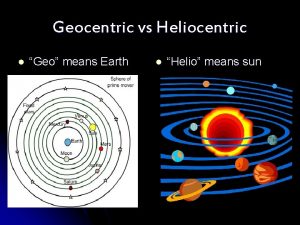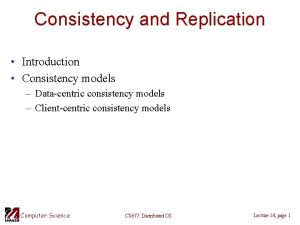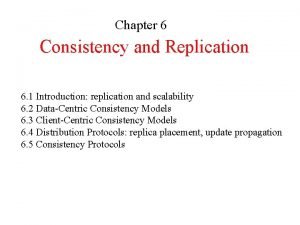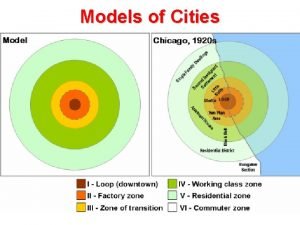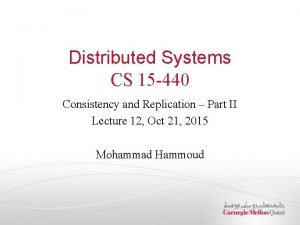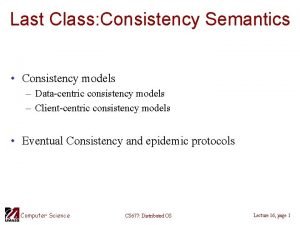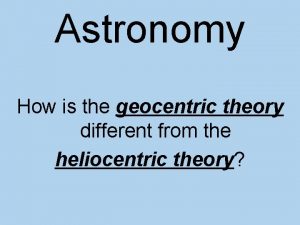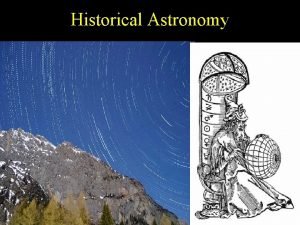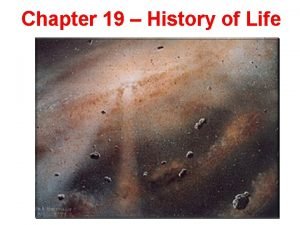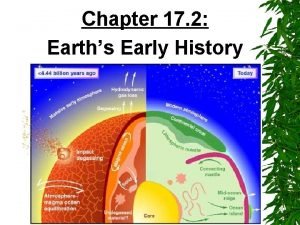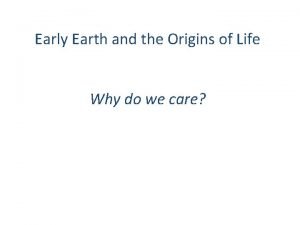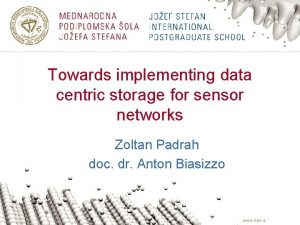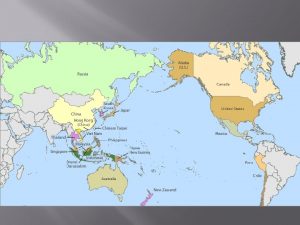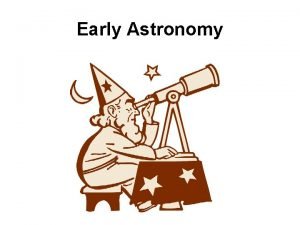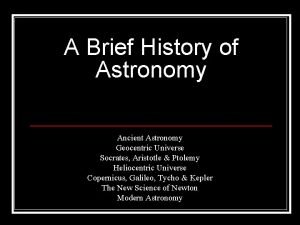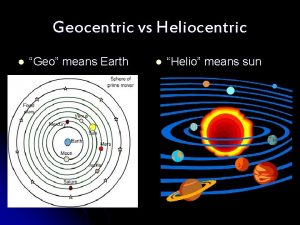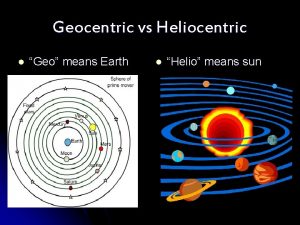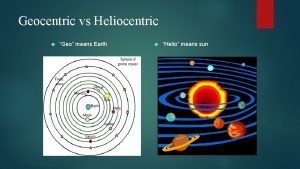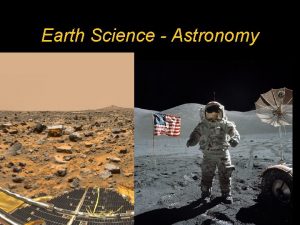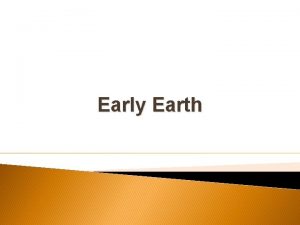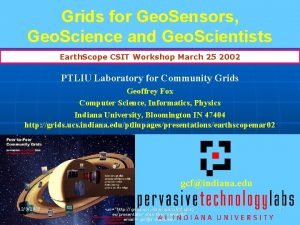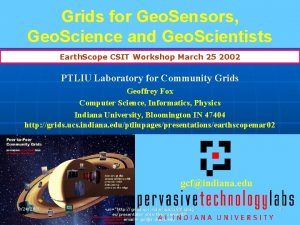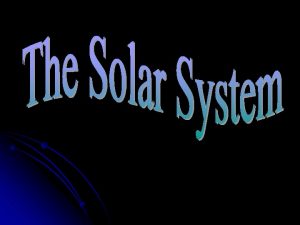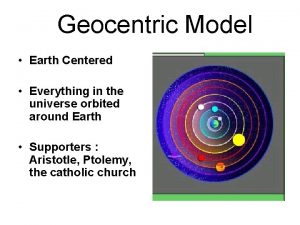Early Astronomy The Geocentric Model Geo Earth Centric






































































- Slides: 70

Early Astronomy

The Geocentric Model Geo = Earth Centric = Centred

Geocentric Model • First described by Aristotle around 300 B. C. • All celestial bodies seem to move across sky from East-West • Earth must be at the centre, with everything moving around us • Moon, Mercury, Venus, Sun, Mars, Jupiter, Saturn – all fixed on circular spheres orbiting the Earth.

• About 400 years later, new discoveries in mathematics showed problems with the Geocentric model • Ptolemy (around 100 A. D. ), updated the model, adding “epicycles” to the orbits of the planets • This helped to explain the retrograde motion of some planets • In total this model lasted for about 2000 years!

The Heliocentric Model • Helio = Sun Centric = Centred

• Copernicus (1500) devises a new model, with the Sun at the centre • Many new discoveries were being made at this time to help prove this model • Kepler (1600) improved the model by using ellipses for the orbits instead of circles


Formation of the Universe • Because it is believed that the Universe is expanding, it must have started off as something small • The Big Bang occurred around 15 -20 billion years ago • Formation of stars and galaxies shortly after

We are all Made of Stars • An average star (like our Sun) lives for about 10 billion years • Therefore, many stars have died out since the Big Bang • When a star explodes and dies, it is called a super nova These explosions supply the energy to make the elements which everything is made up from

The Solar System • The Sun, and anything orbiting the Sun including the planets & their satellites, comets, meteors, and asteroids. • First existed as a solar nebula (a huge cloud of gas and dust) • Gravity pulls the nebula inward, and it begins to rotate • As the nebula rotates, it forms a flat disk

A Rotating Solar Nebula

• The material in the disk is what formed the planets • This is why all the planets are on the same plane, and all orbit in a CCW direction • The material in the centre is what formed the Sun

Galaxy • A large group of stars, gas, and dust bound together by gravitational attractions • The Milky Way is our galaxy • There approx 200 billion stars in the Milky Way • Scientist estimate that there are 100’s of billions of galaxies

The Universe • All space, along with all the matter and radiation in space • Anything and everything!





Solar Distances l Distances on Earth are measured in a variety of units, depending on the distance l If really small: l Size of a school: l From WPG to VAN: Micrometers Meters Kilometres

l Units must change, because it would not make sense to measure the distance from Winnipeg to Vancouver in millimetres! l If this distance was 1900 km, how many mm? l Almost 2 billion! l 1900 km = 1, 900, 000 mm

Solar System Measurements l The distance from the Sun to the Earth is 155 million km l This is too large of a number to use, therefore when measuring distances in the Solar System we use Astronomical Units l Each AU = 155 million km

Outside the Solar System l For any measurements outside the Solar System, the AU is not very useful l Closest star (Proxima Centauri) is 270 000 AU away l Therefore we need to use a new unit

Light Year l. A light Year is the distance light can travel in one year l Light moves at 3 X 108 m/s l Earth is 155 million km away l How long does it take light to reach the Earth?

l 1) Change km to m 1. 55 X 108 km = 1. 55 X 1011 m l 2) Divide this distance by the speed of light 1. 55 X 1011 m / 3 X 108 m/s = 516. 75 s


The Third Rock From The Sun A geologically active planet - earthquakes, volcanoes - erosion from wind & water Large amounts of liquid water - 70% of Earth’s surface Unique atmosphere among the planets - 80% nitrogen, 19% oxygen

• When the Earth first formed (4. 6 billion years ago) it was entirely molten • Heavier elements sank towards the centre • Lighter elements rose towards the surface • Solid inner core (iron), molten outer core, mantle, crust

Earth in Space • The Earth revolves around the Sun once every 365 days • The Earth rotates on it’s axis once every 24 hours • The axis is tilted 23. 5 degrees • Always pointed in the same direction (North Star)

Reasons for the Seasons • For half the year the Northern Hemisphere is tilted toward the Sun (Summer!) • For half the year the Northern Hemisphere is tilted away from the Sun (Winter) • This is the cause of the seasons!

Important Dates • • June 21: Summer Solstice Arctic circle 24 hours daylight March 21, Sept. 21: Spring & Fall Equinox Everywhere receives 12 hours of day & night • Dec 21: Winter Solstice • Arctic circle 24 hours of darkness


The Moon • The most visible object in the night sky • Can see surface features with the naked eye (Light grey/dark grey areas) • Dark grey areas called “Maria” • Latin for sea (People used to think these areas were large bodies of water)

Characteristics • • • The Moon has many craters Most small, but some up to 100 km No water on the moon No atmosphere Surface covered with a fine powder and rock fragments

How did the Moon Form? • Early Earth struck by Mars sized object • Tons of debris flown into space, orbits around the Earth • This debris later condensed together to form the Moon • Proof for this is in the composition of the Moon

Moon Movements • The Moon revolves around the Earth every 27 days • The Moon revolves at the same rate it rotates on its axis (1 moon day = 27 days!) • Because of this, we never see the far side of the Moon • New moon to full moon: Waxing • Full moon to new moon: Waning


The Sun • The only star in our SS • Makes up 99. 9% of all the mass in the SS • The source of almost all the energy on Earth. • Where does this energy come from?

Thermonuclear Reactions • The Sun is made up of mostly Hydrogen and Helium atoms • It is so hot at the core that 2 hydrogen atoms can fuse together to form helium • This is called nuclear fusion • Power plants use nuclear fision (opposite)

Sun Atmosphere • The photosphere is the visible layer of the Sun • Not really a “surface” • The chromosphere is visible only during an eclipse • The corona is the outermost region of the Sun’s atmosphere

Sun Spots • Regions of the photosphere that appear dark because they are cooler than the surrounding areas • Can be about the size of the Earth • Galileo first discovered sunspots • He found they moved across the sun • This proved the sun rotated on its axis

• • Sunspot cycle every 11 years Last sunspot maximum: 2001 Last sunspot minimum: 1996 When there are many sunspots, Earth is usually warmer • When there are fewer sunspots, Earth is usually colder



Solar Flares • Huge eruptions from the photosphere • Occur in large sunspot groups • Radiation from these flares hit Earth, interfere with radio communication, create intense northern lights


Asteroids • Left over pieces of rock and metal that did not form planets • Large asteroid belt between Mars and Jupiter…………Destroyed planet? ? ? • Some up to 1000 km in diameter • Paths crossing other asteroids, moons, and planets


Comets • AKA “dirty snowballs” • Humans have been aware of comets for a very long time, often considered bad omens • Discovered that comets reappear in cycles • Halley’s Comet: Every 76 years. • Last appearance in 1986, next in 2061

• Comets are made of two parts • 1) Head (coma): Small dense nucleus, surrounded by a large gas section • 2) Tail: Made of fine particles of dust and gas. Can be very long • The tail can only be seen when the comet approaches close enough to the Sun for it to melt the iced gas • The tail always points away from the Sun • With each pass, the comet loses some of its mass


Others…… • Meteoroid: Lumps of rock and metal, pulled into Earth’s ATM • Once a meteoroid enters the ATM it burns up due to friction • Meteor: A meteoroid that completely burns up (shooting star) • Meteor showers common several times a year • Meteorite: An unburnt portion, Strikes the Earth

Meteor Showers • On any given night you can expect to see a few “shooting stars” each hour • At certain times though, you can see many more • Jan 4 110/h • Aug 12 68/h • Oct. 21 30/h • Nov. 17 10/h • Dec. 14 58/h



Stars • If you ever looked up at the night sky, you can see that the stars are not all the same • They vary in Brightness • They vary in colour • They vary in size

Star Brightness • Depends on the distance and size of the star • The Sun is so bright because it is so close to us, but it is only an average star • Luminosity: A measure of the total amount of energy a star radiates per second • Some stars are 30, 000 times more luminous than the Sun

Star Colour • Stars come in a variety of colours • Scientists can tell the surface temperature by the colour of the star • Red stars are cooler (Surface T 3000 C) • Blue stars are hotter (Surface T 20000 C) • The Sun is a yellow star (6000 C)

Star Size • Stars come in a variety of sizes • Small stars are called dwarfs • Large stars are called giants • Our star is an average star

Dwarf Stars • Low mass stars • Slowly convert hydrogen into helium (over 100 billion years) • May stay a dwarf all its life, our start as an average star, and turn into a dwarf • Red, white and Black dwarf stars depending on age

Average Stars • Consume their hydrogen in about 10 billion years • (Our sun is about 5 billion years old) • Once H is burned up, energy production stops • Core collapses due to gravity • Increased T = increased pressure

• The outer layers of the star begin to expand • May become 100 times its original size • Now called a red giant • When our Sun reaches this stage it will engulf Mercury, Venus, Earth and Mars! • Eventually the outer gases are burnt off, and all that is left is a super dense core

Massive Stars • • • Consume their hydrogen more rapidly Millions of years, not billions These stars become super giants Life span shorter, but more energetic Two fates once core collapses and explodes (super nova) • The star may turn into a neutron star, or a black hole

Space Technology • Telescope: a device used to magnify distant objects • Come in all sizes and shapes • Refractor telescope uses glass lenses • Reflector telescope uses mirror lenses • The wider the telescope, the more light it can process

Observatories • A building designed and equipped with a powerful telescope to observe the night sky • Best places: Arid regions, mountain tops • Above cloud cover, away from light pollution • Hawaii & Chile are two of the best places in the world, multiple observatories


Hubble Telescope • What better place for a telescope than outerspace? • Launched in 1990 • Orbiting 600 km above the Earth • Built by the European Space Agency (ESA) and NASA • Starting to become outdated


The Future • The next generation telescope coming in 2009 • Called the James Web Space Telescope

Mir Space Station • Launched in 1986 by the Russians • Since then has had multiple upgrades • Serves as a permanent site for astronomers to conduct their research • Shared by multiple countries

 Network centric computing
Network centric computing Mention region centric and geocentric orientations.
Mention region centric and geocentric orientations. Learning astronomy by doing astronomy
Learning astronomy by doing astronomy Learning astronomy by doing astronomy
Learning astronomy by doing astronomy Learning astronomy by doing astronomy activity 1 answers
Learning astronomy by doing astronomy activity 1 answers Geology earth science definition
Geology earth science definition Heliocentric vs geocentric
Heliocentric vs geocentric Whats the difference between heliocentric and geocentric
Whats the difference between heliocentric and geocentric Geo means earth
Geo means earth Explain data centric consistency model
Explain data centric consistency model Explain data centric consistency model
Explain data centric consistency model Cocentric model
Cocentric model Continuous consistency in distributed system
Continuous consistency in distributed system Consistency in science
Consistency in science Monotonic read consistency
Monotonic read consistency Early cpr and early defibrillation can: *
Early cpr and early defibrillation can: * How does the geocentric model work
How does the geocentric model work Geocentric model
Geocentric model Heliocentric theory
Heliocentric theory Geocentric model
Geocentric model Joshua 10:13
Joshua 10:13 Section 17-2 earth's early history answer key
Section 17-2 earth's early history answer key 17-2 earth's early history
17-2 earth's early history Section 17-2 earth's early history
Section 17-2 earth's early history Early earth life
Early earth life The early earth of the hadean eon _____.
The early earth of the hadean eon _____. Jaws
Jaws Incipient mass tourist
Incipient mass tourist Non centric cusp
Non centric cusp Centric relationship
Centric relationship Lingual cusp
Lingual cusp Symantec information centric tagging
Symantec information centric tagging Data driven coaching
Data driven coaching Centric federal credit union
Centric federal credit union Document centric web application
Document centric web application Data-centric storage
Data-centric storage Data-centric pathology
Data-centric pathology Laboratory remount
Laboratory remount Occlusion definition in orthodontics
Occlusion definition in orthodontics Designing learner-centric moocs
Designing learner-centric moocs World map eurocentric
World map eurocentric The function of the compensating curve is
The function of the compensating curve is Hyatt centric long beach ca
Hyatt centric long beach ca Net-centric computing
Net-centric computing Designing learner-centric moocs
Designing learner-centric moocs Power centric solutions
Power centric solutions Knowledge management value proposition
Knowledge management value proposition Value centric appraisals
Value centric appraisals Network centric solutions
Network centric solutions Content centric approach
Content centric approach Donor centric fundraising
Donor centric fundraising Centric staffing
Centric staffing Process centric oss
Process centric oss Information centric networking
Information centric networking Cpdas
Cpdas Fifo consistency
Fifo consistency Partner centric
Partner centric Hát kết hợp bộ gõ cơ thể
Hát kết hợp bộ gõ cơ thể Frameset trong html5
Frameset trong html5 Bổ thể
Bổ thể Tỉ lệ cơ thể trẻ em
Tỉ lệ cơ thể trẻ em Voi kéo gỗ như thế nào
Voi kéo gỗ như thế nào Chụp phim tư thế worms-breton
Chụp phim tư thế worms-breton Bài hát chúa yêu trần thế alleluia
Bài hát chúa yêu trần thế alleluia Môn thể thao bắt đầu bằng chữ f
Môn thể thao bắt đầu bằng chữ f Thế nào là hệ số cao nhất
Thế nào là hệ số cao nhất Các châu lục và đại dương trên thế giới
Các châu lục và đại dương trên thế giới Công thức tiính động năng
Công thức tiính động năng Trời xanh đây là của chúng ta thể thơ
Trời xanh đây là của chúng ta thể thơ Mật thư tọa độ 5x5
Mật thư tọa độ 5x5 Làm thế nào để 102-1=99
Làm thế nào để 102-1=99








